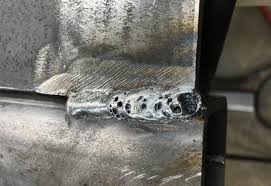What is Porosity in Welding: Trick Factors and Their Effect On Weld High Quality
What is Porosity in Welding: Trick Factors and Their Effect On Weld High Quality
Blog Article
The Science Behind Porosity: A Comprehensive Guide for Welders and Fabricators
Comprehending the intricate devices behind porosity in welding is critical for welders and producers pursuing impressive craftsmanship. As metalworkers dive right into the depths of this phenomenon, they reveal a globe regulated by numerous variables that affect the formation of these minuscule spaces within welds. From the composition of the base products to the ins and outs of the welding procedure itself, a plethora of variables conspire to either exacerbate or relieve the visibility of porosity. In this detailed overview, we will certainly decipher the science behind porosity, exploring its effects on weld top quality and introduction advanced strategies for its control. Join us on this journey with the microcosm of welding imperfections, where accuracy satisfies understanding in the quest of perfect welds.
Comprehending Porosity in Welding
FIRST SENTENCE:
Evaluation of porosity in welding reveals important insights right into the integrity and top quality of the weld joint. Porosity, defined by the existence of tooth cavities or voids within the weld metal, is a common problem in welding procedures. These gaps, if not correctly dealt with, can endanger the architectural integrity and mechanical homes of the weld, leading to possible failures in the finished product.

To spot and evaluate porosity, non-destructive screening methods such as ultrasonic testing or X-ray assessment are commonly employed. These methods enable the recognition of interior problems without jeopardizing the stability of the weld. By evaluating the dimension, form, and distribution of porosity within a weld, welders can make informed decisions to enhance their welding processes and attain sounder weld joints.

Aspects Influencing Porosity Development
The occurrence of porosity in welding is influenced by a myriad of factors, ranging from gas securing effectiveness to the intricacies of welding specification setups. Welding parameters, consisting of voltage, current, take a trip rate, and electrode kind, also impact porosity formation. The welding strategy used, such as gas metal arc welding (GMAW) or shielded metal arc welding (SMAW), can influence porosity formation due to variants in heat circulation and gas coverage - What is Porosity.
Effects of Porosity on Weld High Quality
Porosity development significantly endangers the architectural stability and mechanical properties of welded joints. When porosity is present in a weld, it creates voids or dental check over here caries within the material, minimizing the general strength of the joint. These gaps work as stress concentration factors, making the weld extra susceptible to fracturing and failing under load. The presence of porosity also deteriorates the weld's resistance to corrosion, as the caught air or gases within deep spaces can respond with the surrounding setting, bring about destruction gradually. Furthermore, porosity can impede the weld's capability to stand up to pressure or influence, further threatening the total quality and dependability of the welded structure. In crucial applications such as aerospace, automotive, or structural constructions, where safety and durability are paramount, the damaging effects of porosity on weld quality can have extreme consequences, emphasizing the importance of minimizing porosity through proper welding strategies and procedures.
Strategies to Lessen Porosity
To improve the high quality of welded joints and make sure structural honesty, welders and makers this website use certain strategies targeted at decreasing the formation of spaces and dental caries within the product throughout the welding process. One effective method to reduce porosity is to make certain correct material prep work. This includes comprehensive cleansing of the base steel to get rid of any impurities such as oil, oil, or moisture that can add to porosity formation. Additionally, using the appropriate welding specifications, such as the appropriate voltage, current, and take a trip speed, is important in avoiding porosity. Keeping a consistent arc size and angle during welding also helps in reducing the likelihood of porosity.

Making use of the suitable welding technique, such as back-stepping or employing a weaving movement, can likewise aid disperse heat equally and minimize the chances of porosity development. By carrying out these techniques, welders can properly lessen porosity and create high-grade bonded joints.

Advanced Solutions for Porosity Control
Implementing sophisticated modern technologies and ingenious techniques plays a crucial function in achieving premium control over porosity in welding processes. One advanced service is making use of advanced gas mixes. Protecting gases like helium or a mixture of argon and hydrogen can assist reduce porosity by giving much better arc security and improved gas coverage. Additionally, employing innovative welding methods such as pulsed MIG welding or changed atmosphere welding can likewise help reduce porosity problems.
An additional sophisticated service entails using advanced welding devices. Making use of tools with integrated attributes like waveform control and sophisticated power resources can boost weld high quality and reduce porosity dangers. The application of automated welding systems with precise control over specifications can considerably lessen porosity issues.
Furthermore, integrating sophisticated surveillance and assessment technologies such as real-time X-ray imaging or automated ultrasonic screening can assist in spotting porosity early in the welding process, permitting immediate restorative actions. In general, incorporating these innovative solutions can greatly boost porosity control and boost the total top quality of bonded parts.
Conclusion
Finally, recognizing the scientific research behind porosity in welding is crucial for welders and makers to create top quality welds. By identifying the elements influencing porosity formation and applying techniques to reduce it, click to find out more welders can improve the total weld high quality. Advanced remedies for porosity control can additionally enhance the welding process and guarantee a strong and reliable weld. It is necessary for welders to continuously enlighten themselves on porosity and carry out best techniques to achieve ideal results.
Report this page